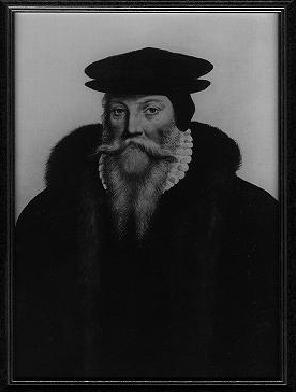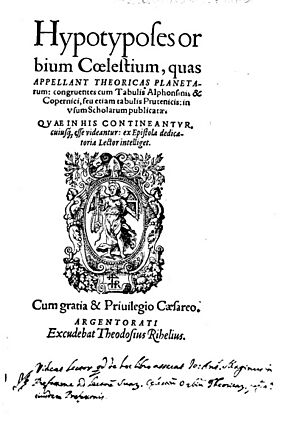Caspar Peucer facts for kids
Quick facts for kids
Caspar Peucer
|
|
|---|---|

Caspar Peucer
|
|
| Born | January 6, 1525 Bautzen, Germany
|
| Died | September 25, 1602 (aged 77) Dessau, Germany
|
| Scientific career | |
| Fields | Mathematics, astronomy, astrology, and medicine |
| Academic advisors | Erasmus Reinhold Georg Joachim Rheticus |
| Notable students | Tycho Brahe Johannes Praetorius Salomon Alberti |
Caspar Peucer (January 6, 1525 – September 25, 1602) was an important German reformer, physician, and scholar. He was of Sorbian origin. He made many contributions to mathematics, astronomy, astrology, and medicine.
Contents
Caspar Peucer's Life Story
Early Years
Caspar Peucer was born on January 6, 1525, in Bautzen, Germany. His father, Gregor Peucer, was a respected craftsman. His mother was Ottilie Simon. Gregor Peucer was trusted by the leaders of Bautzen. This shows that the family was well-connected. Caspar's education started in his hometown. He went to a local Protestant grammar school. This school was known for its excellent teaching.
Becoming a Scholar
Later, Peucer went to a Latin school run by Valentin Friedland. Here, he learned about the new Lutheran ideas in education. He then went to the University of Saxon Wittenberg in March 1543. This university was a center for the Protestant Reformation. He earned his master's degree in September 1545.
After graduating, Peucer quickly became a professor at Wittenberg. He started teaching lower mathematics in 1550. By 1554, he was teaching higher mathematics. He taught alongside famous mathematicians like Erasmus Reinhold. Peucer also helped promote the astrology program at the university. He believed astrology was important for understanding God's creation. In 1560, he earned his medical doctor title. Peucer married Magdalena, the daughter of the famous theologian Philipp Melanchthon. They had three sons and seven daughters. Magdalena passed away in 1575.
Later Life and Challenges
Around 1570, Peucer became the doctor for August, the Elector of Saxony. The Elector was a powerful leader at the time. Peucer became one of August's trusted advisors. He also led a group called the Philippists. This group wanted to gain more followers for the Lutheran church. However, some people suspected Peucer had ties to Calvinism. Calvinism was another Protestant religion. It was founded by John Calvin.
Peucer was accused of supporting Calvinism. He was arrested on April 1, 1574, in Wittenberg. His writings were searched. He had to explain his religious views. He was charged with Calvinism. This was because of his ideas about the Lord's Supper. Strict Lutherans believed Christ was physically present in the Eucharist. Peucer's views were different. He pleaded not guilty. But he was found guilty based on his writings.
This led to Peucer spending twelve years in prison. He was first held in Rochlitz castle. His wife, Magdalena, could stay with him there. Later, he was moved to Leipzig. He could no longer teach math, astronomy, or medicine. Instead, he wrote poetry. He wrote a long poem about his birthplace. His family worked to get him released early. He was finally freed in 1586. After his release, he became the personal doctor to a princess in Dessau. He passed away there on September 25, 1602.
Peucer also worked with the famous astronomer Tycho Brahe. They exchanged letters. Peucer even helped Brahe in a disagreement. This was about Brahe's new system for the universe.
Caspar Peucer's Jobs and Roles
- Professor at the University of Wittenberg (1550–1559)
- Rector (head) of the University of Wittenberg
- Philosopher
- Medical doctor (from 1560)
- Physician to August of Saxony (from 1570)
- Astronomer
- Astrological correspondent (someone who studied and wrote about astrology)
Caspar Peucer's Religious Ideas
Caspar Peucer was a Protestant. He believed in Divine Providence. This means he thought God could and did get involved in nature. Protestant astrologers believed that God or even the devil could send messages through nature. These messages could be seen in medical diagnoses, horoscopes, and weather events. Peucer believed God was the only one who could truly change nature.
Peucer recorded how stars and weather events could be signs. He thought they warned of historical events. This idea of divine providence in astrology was different from what many Catholics and Lutherans believed. They thought linking natural signs to future events went against human free will.
Peucer also believed in angels and demons. He thought they could cause strange events. For example, he thought they might explain comets. He believed these events could somewhat predict the future. He felt there would be no point in such signs if they meant nothing.
Peucer saw two purposes for weather: a natural one and a divine one. He thought weather affected human behavior. This was the "natural cause." He also believed weather could be a "divine cause," giving warnings or signs. He thought angels and demons could cause things like earthquakes. This showed that God cared enough to intervene in nature.
During Peucer's time, science and religion often supported each other. His Christian beliefs led him to support the geocentric model of the universe. This model, by Ptolemy, put Earth at the center. In 1543, Copernicus proposed a heliocentric model, with the sun at the center. But Peucer did not accept Copernicus's idea. Christians at the time believed Earth had to be the center of the cosmos.
Religious Disagreements
There were strict rules about the Lord's Supper. Any changes to its traditions could be punished. Peucer got into trouble for his different view. He did not believe Christ was physically present in the bread. Because Peucer was a powerful figure in education, he could hire teachers who were Philippists. These teachers followed Philip Melanchthon's ideas.
Peucer was imprisoned for about ten years (1576-1586). He was also removed from the University of Wittenberg. This was mainly because he was secretly thought to be a Calvinist. He also had other religious differences with Elector August of Saxony. August strongly disliked Calvinism. This led to Peucer's imprisonment. His imprisonment slowed down philosophical teaching. It also damaged his reputation and power at Wittenberg. He was finally released in 1587 after August of Saxony died.
Caspar Peucer's Writings
Peucer wrote about mathematics, astronomy, geometry, and medicine. He also edited some of Melanchthon's letters. Here are some of his works:
- De dimensione terrae (1550) - About measuring the Earth.
- Elementa doctrinae de circulis coelestibus et primo motu (1551) - About the movements of heavenly bodies.
- Tractatus historicus de Ph. Melanchthonis sententia de controversia coenae Domini, 1553 (printed 1596) - About Melanchthon's views on the Lord's Supper.
- Commentarius de praecipuis divinationum generibus, 1553 - This book tried to prove astrology was a science.
- Logistice regulae arithmeticae, quam Cossam et Algebram vocant (1556) - About arithmetic rules, also called Algebra.
- Corpus Doctrinae Philippicum, 1560 - A collection of Philippist teachings.
- Chronicon Carionis (1560-1565) - A historical chronicle.
- Opera Melan, 1562–65 - Melanchthon's collected works.
- Epistolae, 1565 - Letters.
- De Essentia et ortu animae 1590 - About the connection between stars and the soul.
- Idyllion de Lusatia, 1583 (printed 1594) - A poem about his birthplace.
De Dimensione Terrae (1550)
Peucer's book, De Dimensione Terrae (On the Dimensions of the Earth), was first published in 1550. He was 25 years old then. It was meant to be a textbook for students studying philosophy at the University of Wittenberg. The book covered physics, astronomy, astrology, and history. It built on the work of Melanchthon. It used simple figures to help students understand. However, some math calculations in the book were very advanced.
The first edition in 1550 showed how to measure spheres. It also explained how to find geographical coordinates. The 1554 edition added calculations. These helped find the distance between two points using coordinates. The ideas in this book came from the works of Copernicus, Georg Joachim Rheticus, and Johnannes Regiomantus. The 1554 version also included descriptions of the Holy Land. Peucer believed that humans calculating the Earth's nature showed "Divine Providence." This meant it showed God's actions in the world.
In the book, Peucer stressed that history should be understood in a Christian way. Geography should be seen in mathematical terms. He wanted to inspire students to improve map-making. He explained how to calculate longitude. This needed two people in different places to record the same event. They also needed to know the exact time. This showed the need for accurate timekeeping. Peucer wanted to make maps more precise. He aimed for detailed mathematical maps. He described methods for calculating distances. He used concepts like equators, poles, and meridians. He also used longitude and latitude to create imaginary triangles. Then, he used simple math to find the distances.
Peucer knew that the advanced math in his book might be too hard for many students. He suggested that students could use simpler methods if needed. This allowed classes to choose how deep they wanted to go. They could stick to the basic math or tackle the more complex parts. Despite its difficulty, this book was used in math classes until the late 1580s. Many copies were found in libraries across Europe.
Who Influenced Caspar Peucer?
Caspar Peucer studied many subjects. His most famous work was in astrology and medicine. His ideas were influenced by Aristotle, Ptolemy, and Copernicus. He and his friends preferred the ideas of Aristotle and Ptolemy. They liked the geocentric system. This system placed Earth at the center of the universe. Copernicus's heliocentric system put the sun at the center. Peucer did not agree with Earth moving in Copernicus's system.
Philip Melanchthon was another big influence on Peucer. Melanchthon was known for his work in theology. Peucer was one of Melanchthon's closest students. He later married Melanchthon's daughter, Magdalena. Melanchthon's students were called 'Philippists'. They studied and wrote many works under his teaching. They believed Melanchthon could understand divine providence through astrology. The Philippists were also inspired by Girolamo Cardano. Cardano was a medicine professor. He was known for his medical, philosophical, mathematical, and astrological works. He was famous for drawing horoscopes. Cardano was later tried by a religious court. His astrological ideas were seen as problematic.
Tycho Brahe was a famous astronomer. He didn't directly influence Peucer's work. But they did share their ideas. Tycho disagreed with some of Ptolemy's views on the cosmos. He didn't like Ptolemy's approach to heavenly motions. Peucer, however, liked Ptolemy's views. In 1588, Brahe wrote to Peucer. He explained where Ptolemy's ideas fell short. He also showed how Copernicus's system could fix these issues. Even with Brahe's letter, both he and Peucer disagreed with Earth's movement in the Copernican system. Brahe and Peucer often exchanged ideas. They discussed natural philosophy. But it's not clear if they worked together on research.


